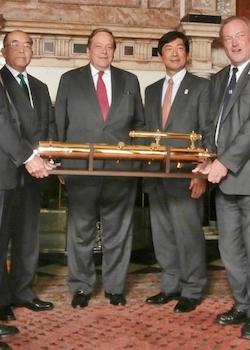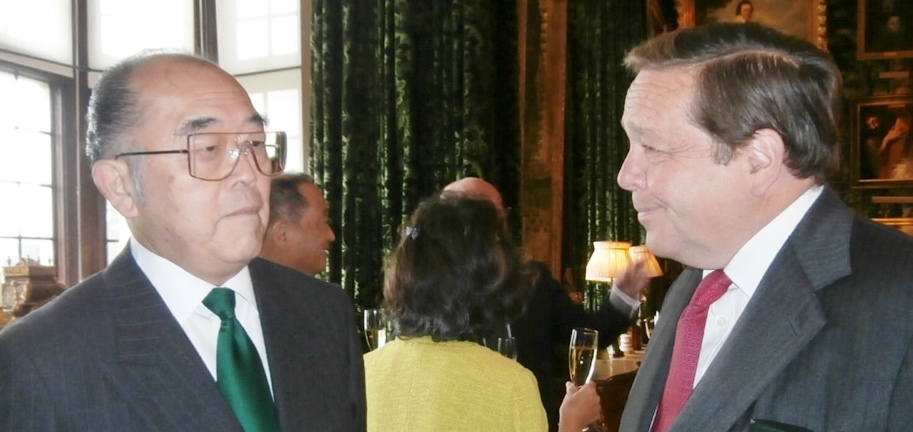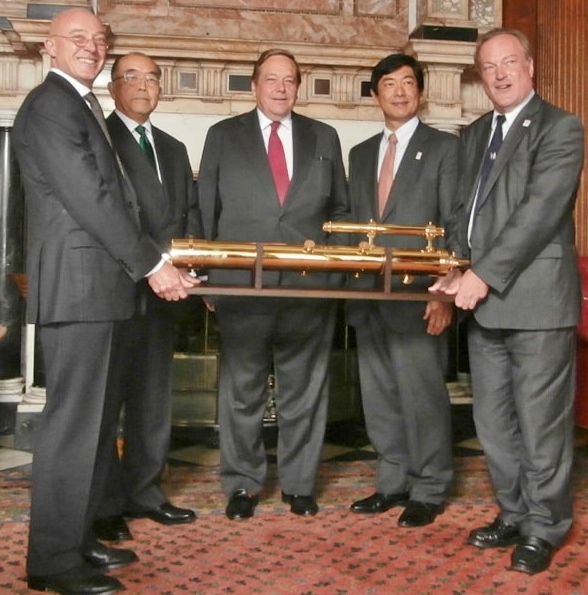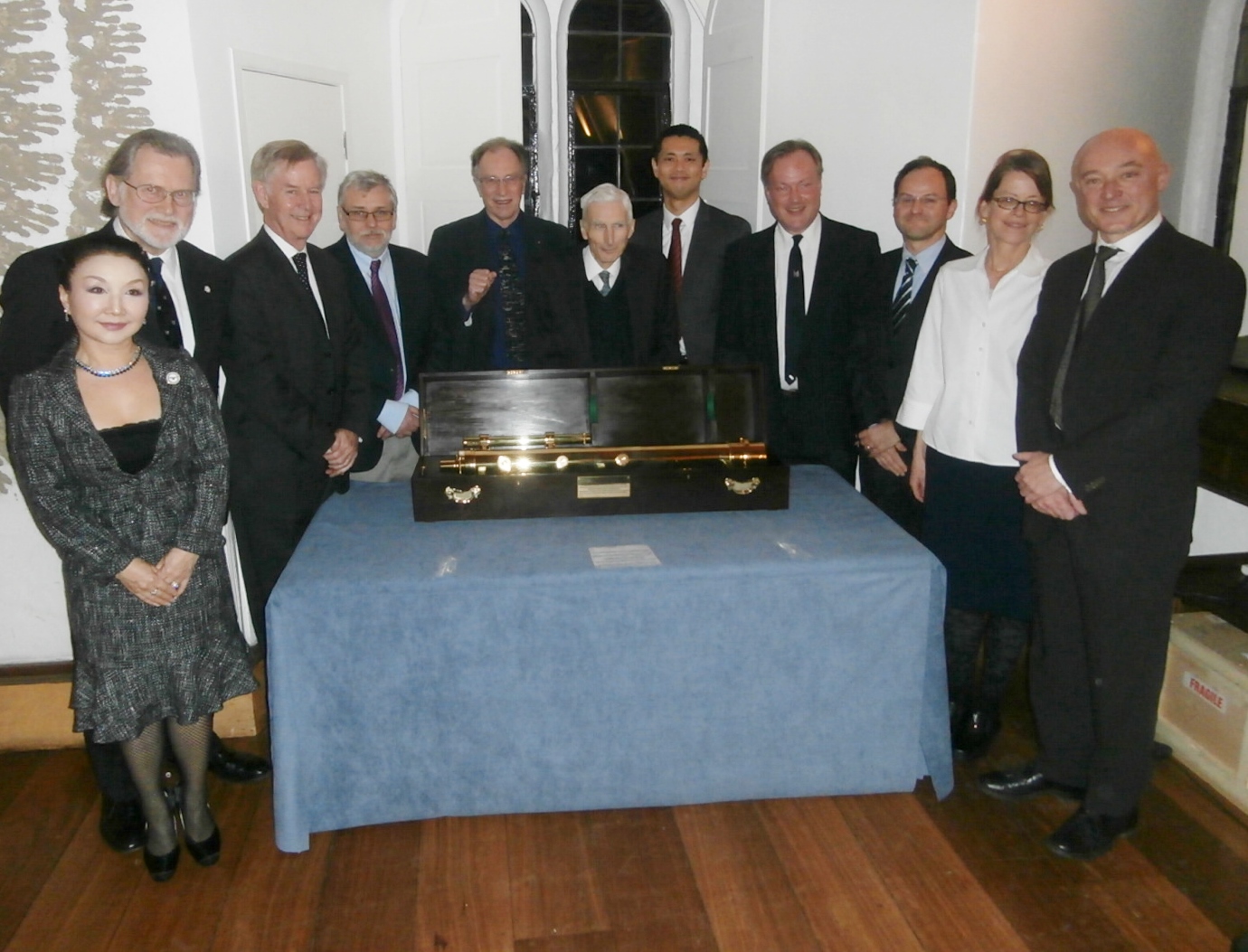The Return of Japan’s Long Lost Telescope

Article by Sean Curtin
Four centuries ago King James I gave Japan its very first telescope, at the time this was a cutting-edge piece of technology. The gift was the perfect symbol to mark the beginning of what was to become an extremely fruitful and long-lasting bilateral relationship. Sadly, the original telescope has been lost to the mists of time, but as part of the Japan400 celebrations in 2013 to mark four centuries since the first official encounter, a new telescope was constructed using traditional methods. The idea of restoring a lost symbolic artefact has deep cultural roots in English mythology and literature stretching back to the Arthurian legends.
The original telescope’s tale begins back in April 1611, when the East India Company ship the Clove, under the command of the intrepid Captain John Saris, left England and set sail for distant Japan. The mission was made up of three ships of which only the Clove went all the way to Japan. Saris’ commission was to first go to Yemen and the Spice Islands, primarily to seek trade, and then to Japan, if possible. Because his first two ports of call were not especially successful, Saris was motivated to go on to Japan. After a dangerous sea voyage lasting more than two years, the Clove arrived in Japanese waters in June 1613. It is believed the Earl of Salisbury, a close advisor and Chief Minister to King James, helped supervise the complex task of sending the first British vessel to Japan and organizing the dispatch of the telescope, which was the most advanced scientific instrument on the planet at the time.
This was a daring mission to what was then the very edge of the known world. After sailing along the Japanese coast, Saris eventually landed at Hirado, located in modern day Nagasaki Prefecture. Here he was warmly greeted by the local ruler, Matsura Hoin, the Lord of Hirado. Lord Matsura helped ensure the telescope’s safe passage to Japan’s paramount ruler, Tokugawa Ieyasu. Along with the aid of William Adams, an Englishman who had arrived in Japan in April 1600 on a Dutch ship, Saris was able to gain an audience with the ruling elite and initiate the first official contact.On 8 September 1613, Saris had an audience with the immensely influential retired Shogun, Tokugawa Ieyasu. He gave the legendary leader a letter from King James and several gifts, including the nation’s first ever telescope, a device which had just been invented in Europe. Saris also opened a trading post and factory in Hirado, which he subsequently handed over to his colleague Richard Cocks upon departing Japan in December 1613.
The spyglass brought by Saris was the first to leave Europe for any destination, as well as the first ever sent to Asia. To the people of the time, the telescope was a fabulous piece of technology and certainly a truly impressive gift. Sadly, all physical traces of this magnificent device have completely vanished and we do not even have a picture of it. The surviving written Japanese texts describing the telescope are contradictory, so we have no real idea what it was actually like.
In many respects this first gift of such an innovative piece of world-changing technology was the perfect symbol to inaugurate a highly successful, centuries-long relationship of scientific, economic and cultural exchange. It is a shame that this potent emblem of friendship no long exists. Thanks to the vision of the Japan400 co-chairs, Professor Timon Screech and Nicolas Maclean CMG, along with the very generous funding for the entire project by Robin Maynard MBE, a new telescope was commissioned in 2013. The new instrument was painstakingly created over a year-long period by Ian Poyser, one of Britain’s foremost craftsmen in the field of traditional brass telescope construction.
Having recreated such a historic symbol from the genesis of the Japan-British relationship, a fitting location and occasion had to be found for the telescope to make its global debut. Monday 9 September 2013, almost four hundred years to the day from the original presentation, was selected as the date to reveal the newly-commissioned brass instrument. Hatfield House, built by the 1st Earl of Salisbury, who helped organize its dispatch to Japan, was selected as the special venue. To add a further layer of historic resonance, two direct descendants of key 1613 dramatis personae were present at the ceremony. These were the Marquess of Salisbury, descendant of the 1st Earl of Salisbury, and Mr Akira Matsura, descendant of the Lord of Hirado, where the Clove had landed 400 year ago.

ruler of Hirado and the Marquess of Salisbury,
descendant of the 1st Earl of Salisbury.
A lunch was held to celebrate the historic Saris-Tokugawa encounter and the first public appearance of the newly crafted spyglass. It was announced that the beautifully crafted instrument was to be a gift to the Japanese people from Japan400, being given as a renewal of the original gift. It is hoped it will symbolise the centuries-long exchanges in culture, diplomacy and trade between the two great nations as well as the long-standing and mutual cooperation in science and technology. Later that same day, the telescope made its second public outing, this time at the world-famous Tower of London, where the Shogun’s gift to King James, a magnificent suit of Japanese armour, is on display. After its day in the sun, the telescope was returned to the workshop for further internal work to be completed.

The next time the instrument was on display was at the “Two Cultures United by Tea” event organized by Japan400 and held at the magnificent Banqueting House in Whitehall on Sunday 15 September 2013. At this spacious location many people were able to admire it and the general impression of the gleaming brass device was extremely favourable. This was perhaps the best chance the British public had to see it before it returned once again to Mr Poyser’s workshop for a final series of refinements to its optical array. Like the original telescope, it was destined to be dispatched to Japan, but fortunately there would be one final opportunity to view it before it left the UK.
On 17 January 2014, Japan400 and the University of Cambridge organized a unique seminar entitled ‘From King James’s Telescope to the Present and the Future: the Japan-British partnership in science and technology’ at Jesus College, Cambridge, which is one of the university’s most ancient colleges. This conference was kindly sponsored by the Great Britain Sasakawa Foundation and Toshiba of Europe and functioned as a farewell event for the telescope. A highly distinguish academic gathering, including Lord Rees FRS, Astronomer Royal, was assembled to celebrate the 400th anniversary of Japan-British scientific relations and bid adieu to the glistening optical device. The symposium was chaired by Professor Timon Screech and Nicolas Maclean CMG, the co-chairmen of Japan400, and by Professor Roberto Cipolla, Fellow of Jesus College.

and the Future – Symposium and Celebration of the Departure of
the Japan400 Telescope for Japan
After the conference, there was a dinner in honour of the departing telescope. Japan400 will send the telescope to No. 1 House at the British Embassy in Tokyo before it tours a number of Japanese cities with strong British historical connections. It will eventually come to rest in Shizuoka City. The telescope will be a key part of the Ieyasu400 celebrations, which will commemorate the life of the great Japanese leader Tokugawa Ieyasu, who died in June 1616. The telescope will eventually be placed on permanent display in a specially reconstructed tower of Sunpu Castle in Shizuoka City.
The telescope’s farewell dinner was held in one of the oldest parts of Jesus College, which was built on the site of a twelfth-century Benedictine nunnery. This ancient venue gave the proceedings an almost spiritual quality and as I looked at the telescope, it made me recall the Bible passage, “Rejoice with me; for I have found the piece which I had lost (Luke 15:9, King James Version).

